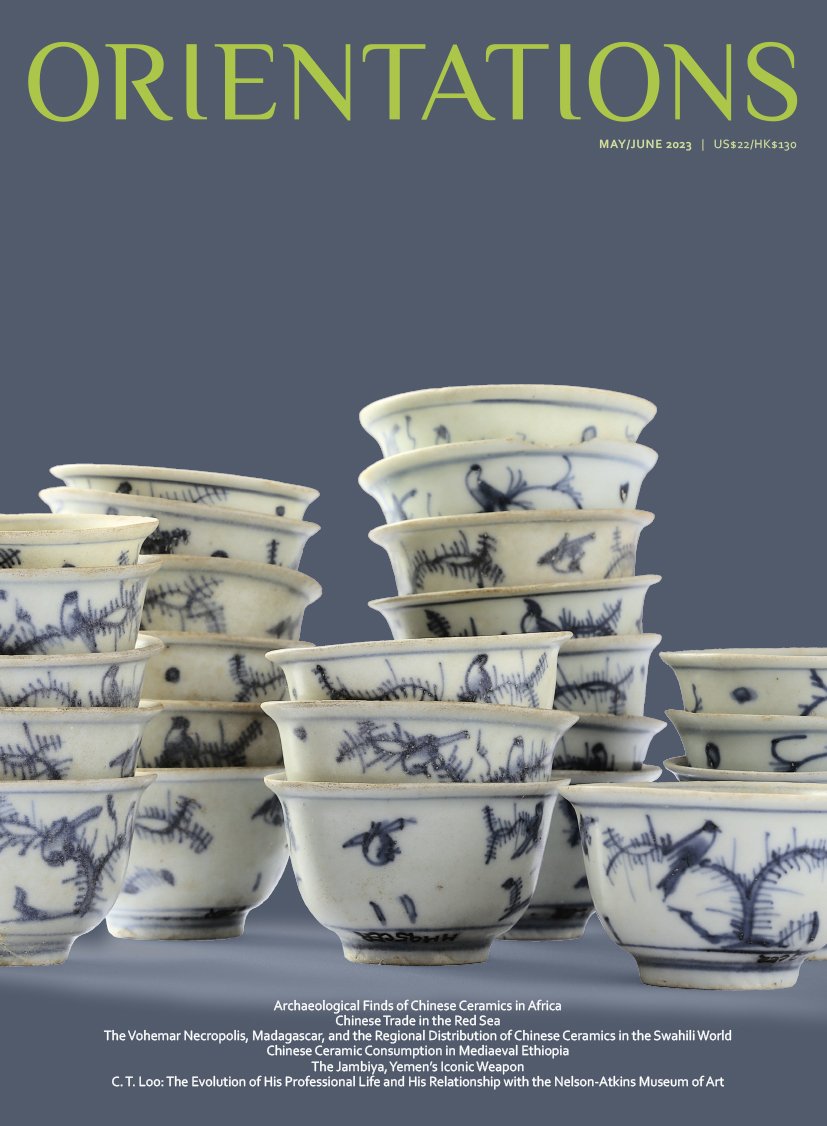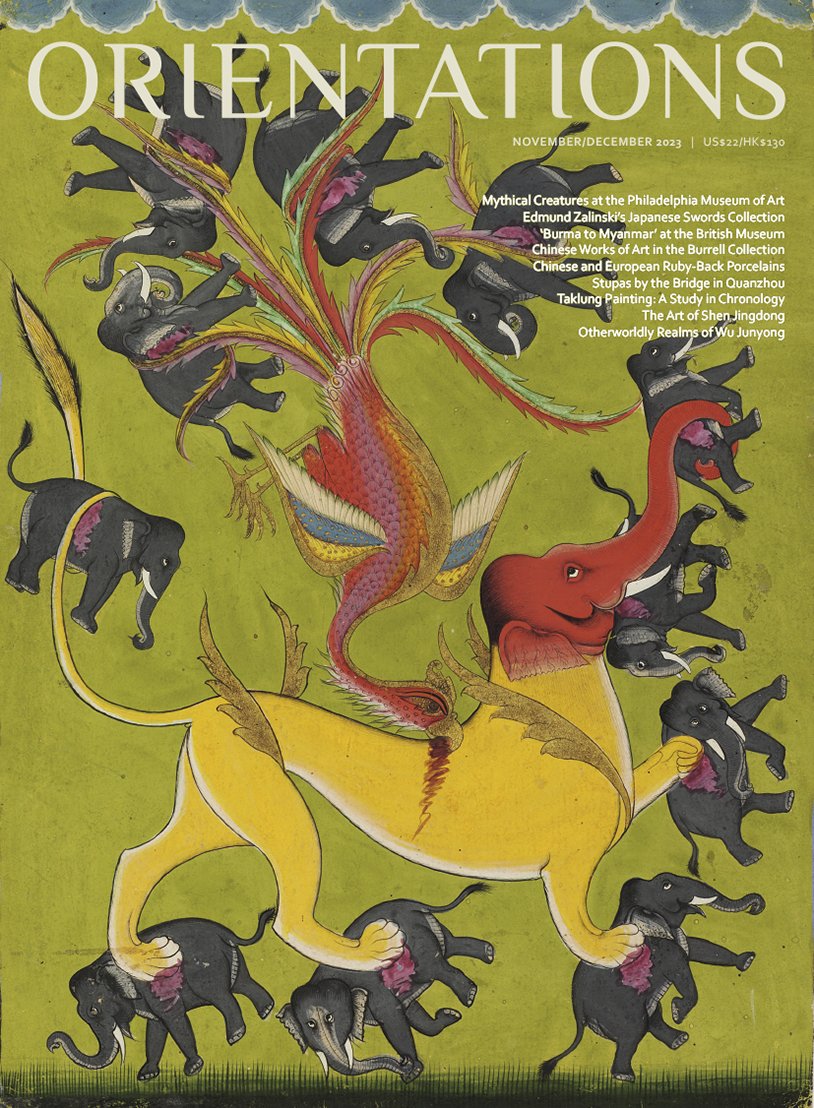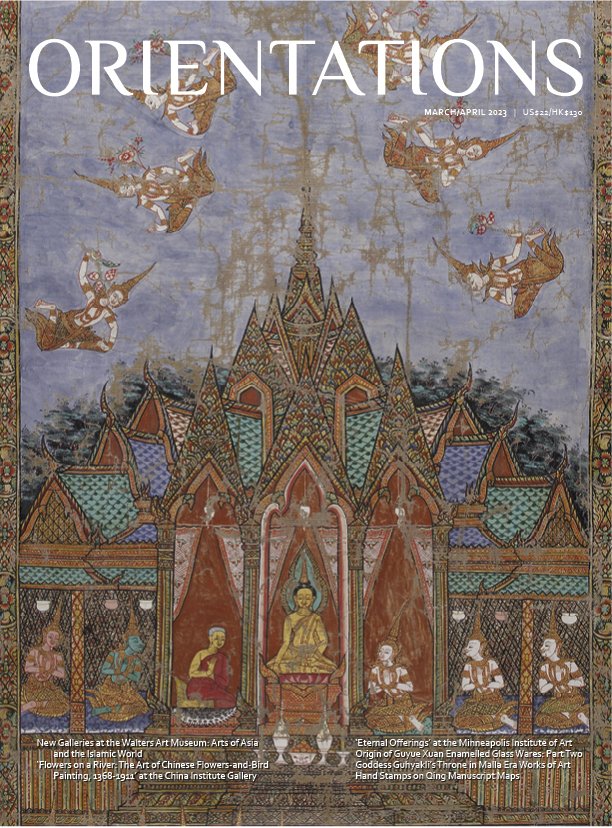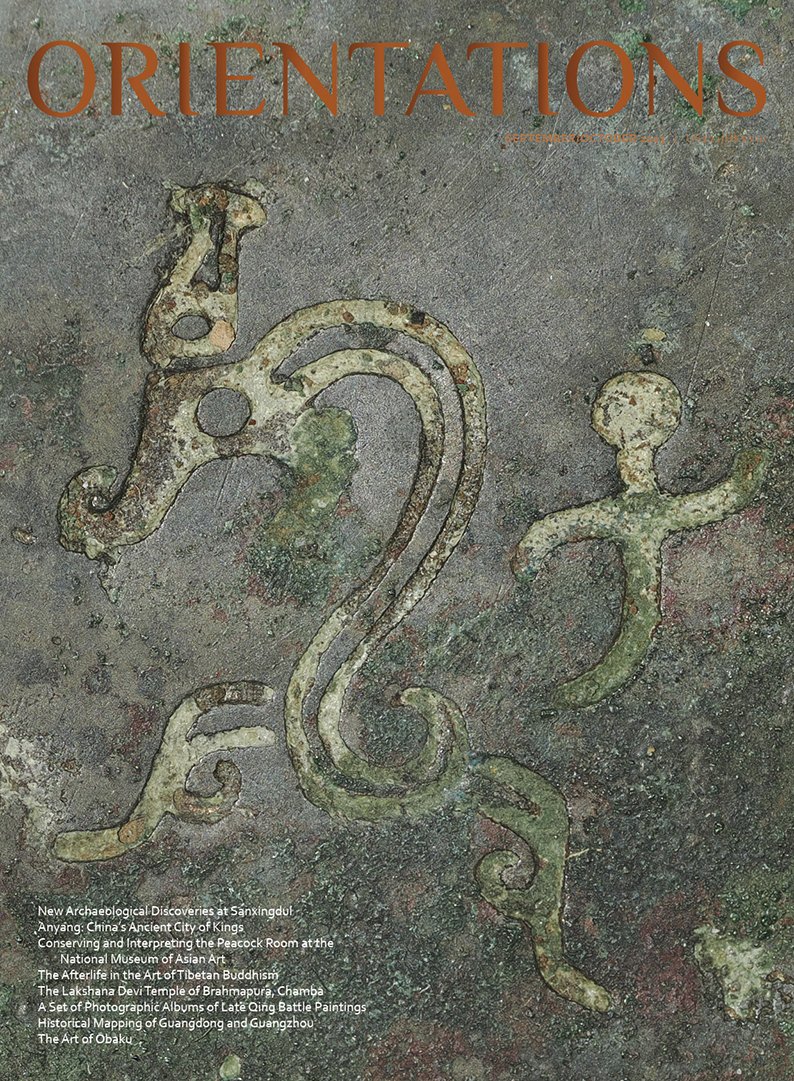MAY/JUN 2023
VOLUME 54 - NUMBER 3
I discovered a small shop in Lamu on my trip to the island off the coast of Kenya in 2017 where the owner made delightful silver jewellery with Chinese ceramics picked up from the beach. Although I have read of Zheng He’s voyages during the Ming dynasty through the South China Sea, Indian Ocean, Arabian Sea, Red Sea, and along the east coast of Africa —and have seen numerous depictions of giraffes on Chinese paintings in museums around the world—the lack of significant collections in East Africa does not bring this region of the world to mind when thinking of Chinese art. Thus, it was fortuitous that Bing Zhao, research director of the East Asian Civilizations Research Centre (French National Centre for Scientific Research) and regular contributor to Orientations, proposed a special issue focusing on archaeological finds of Chinese ceramics in East Africa, especially as we have been devoting since 2021 one issue per year to Asian art to Asian art in areas of the world less well known for it. We are pleased to have Bing Zhao as our guest editor and to share in her knowledge of the interchanges and influences between China and Africa.
Last June, I had the chance to visit legendary dealer C. T. Loo’s Pagoda Paris, a building I had wandered by numerous times before without the chance to see the magnificence of its interior. We interview the owner, Jacqueline von Hammerstein-Loxten, on the birth of the Pagoda and future plans. A part of Loo’s immense success was his wide and complex network of suppliers and collectors. We unravel his professional life and attempt to separate fact from myth. Many museums in the USA and Europe were clients of Loo, one being the Nelson-Atkins Museum of Art in Kansas City. A few years prior to the opening of the museum in 1933, trustees went on a buying spree and Loo was one of the dealers they worked with, purchasing more than 100 objects from him including two temple rooms and numerous iconic sculptures; recent provenance research by the museum on these objects can be found on its website. Lastly, we delve further into the Chinese Temple Room and the Indian Temple Room, their connections with Loo, and how he capitalized on the popularity of period rooms in museums in the late 19th to early 20th century. Regardless of the controversary surrounding his business practices, he undoubtedly made a lasting impact on Western tastes in Asian art and its presentation.
FEATURES
Bing Zhao. Illuminating Sino-African Maritime Exchanges Through Archaeological Finds of Chinese Ceramics in Africa
Clifford Pereira. Imported Ceramics and the Swahili Culture of the Coast of Kenya
Hannah Parsons-Morgan. Chinese Ceramic Consumption in Medieval Ethiopia: An Archaeological Perspective
Bing Zhao. The Vohemar Necropolis, Madagascar, and the Regional Distribution of Chinese Ceramics in the Swahili World (13th–17th century)
Dr Teresa Canepa and Beth Gardiner. Espadarte (1558) Evidence of Early Portuguese Trade in Porcelain via Africa
Roberto Gardellin. Chinese Trade in the Red Sea: Two Shipwrecks with Yuan Blue-and-White Porcelains
Rachel Parikh. Forging a Legacy: The Jambiya, Yemen’s Iconic Weapon
Joanna M. Gohmann. Big Business: The Evolution of C. T. Loo’s Professional Life
MacKenzie Mallon. Collecting Relationships: C. T. Loo and the Nelson-Atkins Museum of Art
Ling-en Lu, Kimberly Masteller, and Michele Valentine. Creating Spaces for Asian Art: C. T. Loo and the Nelson-Atkins Museum of Art
VOLUME 54 - NUMBER 3
I discovered a small shop in Lamu on my trip to the island off the coast of Kenya in 2017 where the owner made delightful silver jewellery with Chinese ceramics picked up from the beach. Although I have read of Zheng He’s voyages during the Ming dynasty through the South China Sea, Indian Ocean, Arabian Sea, Red Sea, and along the east coast of Africa —and have seen numerous depictions of giraffes on Chinese paintings in museums around the world—the lack of significant collections in East Africa does not bring this region of the world to mind when thinking of Chinese art. Thus, it was fortuitous that Bing Zhao, research director of the East Asian Civilizations Research Centre (French National Centre for Scientific Research) and regular contributor to Orientations, proposed a special issue focusing on archaeological finds of Chinese ceramics in East Africa, especially as we have been devoting since 2021 one issue per year to Asian art to Asian art in areas of the world less well known for it. We are pleased to have Bing Zhao as our guest editor and to share in her knowledge of the interchanges and influences between China and Africa.
Last June, I had the chance to visit legendary dealer C. T. Loo’s Pagoda Paris, a building I had wandered by numerous times before without the chance to see the magnificence of its interior. We interview the owner, Jacqueline von Hammerstein-Loxten, on the birth of the Pagoda and future plans. A part of Loo’s immense success was his wide and complex network of suppliers and collectors. We unravel his professional life and attempt to separate fact from myth. Many museums in the USA and Europe were clients of Loo, one being the Nelson-Atkins Museum of Art in Kansas City. A few years prior to the opening of the museum in 1933, trustees went on a buying spree and Loo was one of the dealers they worked with, purchasing more than 100 objects from him including two temple rooms and numerous iconic sculptures; recent provenance research by the museum on these objects can be found on its website. Lastly, we delve further into the Chinese Temple Room and the Indian Temple Room, their connections with Loo, and how he capitalized on the popularity of period rooms in museums in the late 19th to early 20th century. Regardless of the controversary surrounding his business practices, he undoubtedly made a lasting impact on Western tastes in Asian art and its presentation.
FEATURES
Bing Zhao. Illuminating Sino-African Maritime Exchanges Through Archaeological Finds of Chinese Ceramics in Africa
Clifford Pereira. Imported Ceramics and the Swahili Culture of the Coast of Kenya
Hannah Parsons-Morgan. Chinese Ceramic Consumption in Medieval Ethiopia: An Archaeological Perspective
Bing Zhao. The Vohemar Necropolis, Madagascar, and the Regional Distribution of Chinese Ceramics in the Swahili World (13th–17th century)
Dr Teresa Canepa and Beth Gardiner. Espadarte (1558) Evidence of Early Portuguese Trade in Porcelain via Africa
Roberto Gardellin. Chinese Trade in the Red Sea: Two Shipwrecks with Yuan Blue-and-White Porcelains
Rachel Parikh. Forging a Legacy: The Jambiya, Yemen’s Iconic Weapon
Joanna M. Gohmann. Big Business: The Evolution of C. T. Loo’s Professional Life
MacKenzie Mallon. Collecting Relationships: C. T. Loo and the Nelson-Atkins Museum of Art
Ling-en Lu, Kimberly Masteller, and Michele Valentine. Creating Spaces for Asian Art: C. T. Loo and the Nelson-Atkins Museum of Art
VOLUME 54 - NUMBER 3
I discovered a small shop in Lamu on my trip to the island off the coast of Kenya in 2017 where the owner made delightful silver jewellery with Chinese ceramics picked up from the beach. Although I have read of Zheng He’s voyages during the Ming dynasty through the South China Sea, Indian Ocean, Arabian Sea, Red Sea, and along the east coast of Africa —and have seen numerous depictions of giraffes on Chinese paintings in museums around the world—the lack of significant collections in East Africa does not bring this region of the world to mind when thinking of Chinese art. Thus, it was fortuitous that Bing Zhao, research director of the East Asian Civilizations Research Centre (French National Centre for Scientific Research) and regular contributor to Orientations, proposed a special issue focusing on archaeological finds of Chinese ceramics in East Africa, especially as we have been devoting since 2021 one issue per year to Asian art to Asian art in areas of the world less well known for it. We are pleased to have Bing Zhao as our guest editor and to share in her knowledge of the interchanges and influences between China and Africa.
Last June, I had the chance to visit legendary dealer C. T. Loo’s Pagoda Paris, a building I had wandered by numerous times before without the chance to see the magnificence of its interior. We interview the owner, Jacqueline von Hammerstein-Loxten, on the birth of the Pagoda and future plans. A part of Loo’s immense success was his wide and complex network of suppliers and collectors. We unravel his professional life and attempt to separate fact from myth. Many museums in the USA and Europe were clients of Loo, one being the Nelson-Atkins Museum of Art in Kansas City. A few years prior to the opening of the museum in 1933, trustees went on a buying spree and Loo was one of the dealers they worked with, purchasing more than 100 objects from him including two temple rooms and numerous iconic sculptures; recent provenance research by the museum on these objects can be found on its website. Lastly, we delve further into the Chinese Temple Room and the Indian Temple Room, their connections with Loo, and how he capitalized on the popularity of period rooms in museums in the late 19th to early 20th century. Regardless of the controversary surrounding his business practices, he undoubtedly made a lasting impact on Western tastes in Asian art and its presentation.
FEATURES
Bing Zhao. Illuminating Sino-African Maritime Exchanges Through Archaeological Finds of Chinese Ceramics in Africa
Clifford Pereira. Imported Ceramics and the Swahili Culture of the Coast of Kenya
Hannah Parsons-Morgan. Chinese Ceramic Consumption in Medieval Ethiopia: An Archaeological Perspective
Bing Zhao. The Vohemar Necropolis, Madagascar, and the Regional Distribution of Chinese Ceramics in the Swahili World (13th–17th century)
Dr Teresa Canepa and Beth Gardiner. Espadarte (1558) Evidence of Early Portuguese Trade in Porcelain via Africa
Roberto Gardellin. Chinese Trade in the Red Sea: Two Shipwrecks with Yuan Blue-and-White Porcelains
Rachel Parikh. Forging a Legacy: The Jambiya, Yemen’s Iconic Weapon
Joanna M. Gohmann. Big Business: The Evolution of C. T. Loo’s Professional Life
MacKenzie Mallon. Collecting Relationships: C. T. Loo and the Nelson-Atkins Museum of Art
Ling-en Lu, Kimberly Masteller, and Michele Valentine. Creating Spaces for Asian Art: C. T. Loo and the Nelson-Atkins Museum of Art






